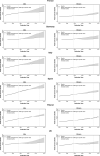Progress in cancer epidemiology: avoided deaths in Europe over the last three decades
- PMID: 34456260
- PMCID: PMC9889194
- DOI: 10.1097/CEJ.0000000000000714
Progress in cancer epidemiology: avoided deaths in Europe over the last three decades
Abstract
Progress in cancer epidemiology and prevention has been a key determinant of the fall in cancer mortality in Europe. Using mortality and population figures from the WHO and Eurostat databases, we estimated the number of averted cancer deaths in the EU27 over the period 1989-2021, for both sexes, for all cancers, and nine major cancer sites. We also computed the avoided deaths for all cancers in five major European countries and the UK. We estimated a total of 4 958 000 (3 339 000 men and 1 619 000 women) avoided deaths for all neoplasms over the period 1989-2021 and 348 000 (246 000 men and 102 000 women) in 2021 alone in the EU27. For both sexes, we estimated 1 679 000 avoided deaths for stomach cancer, 747 000 for colorectum, 227 000 for bladder, 102 000 for leukemias. Avoided deaths for lung cancer accounted for 1 156 000 in men, while no reduction was estimated for women. For breast and uterine cancer, avoided deaths were about 300 000, for ovary 105 000 and for prostate 352 000. In the UK, a total of 1 061 000 (721 000 men and 340 000 women) deaths was avoided. Elimination of tobacco may avoid a further 20% of cancer mortality by 2050. Control of alcohol, overweight and obesity, and occupational and environmental carcinogens may avoid an additional 10% of cancer deaths. A similar reduction may be due to optimal adoption of cervical, colorectal, breast, and probably, lung and prostate cancer screening. Thus, primary and secondary cancer prevention can avoid an additional third of cancer deaths in Europe up to 2050.
Copyright © 2021 Wolters Kluwer Health, Inc. All rights reserved.
Conflict of interest statement
There are no conflicts of interest.
Figures


Similar articles
-
European cancer mortality predictions for the year 2023 with focus on lung cancer.Ann Oncol. 2023 Apr;34(4):410-419. doi: 10.1016/j.annonc.2023.01.010. Epub 2023 Mar 6. Ann Oncol. 2023. PMID: 36882139
-
European cancer mortality predictions for the year 2021 with focus on pancreatic and female lung cancer.Ann Oncol. 2021 Apr;32(4):478-487. doi: 10.1016/j.annonc.2021.01.006. Epub 2021 Feb 21. Ann Oncol. 2021. PMID: 33626377
-
European cancer mortality predictions for the year 2022 with focus on ovarian cancer.Ann Oncol. 2022 Mar;33(3):330-339. doi: 10.1016/j.annonc.2021.12.007. Epub 2022 Jan 26. Ann Oncol. 2022. PMID: 35090748
-
Cancer, cigarette smoking and premature death in Europe: a review including the Recommendations of European Cancer Experts Consensus Meeting, Helsinki, October 1996.Lung Cancer. 1997 May;17(1):1-60. doi: 10.1016/s0169-5002(97)00648-x. Lung Cancer. 1997. PMID: 9194026 Review.
-
Progress of anticancer drugs in reducing mortality from selected cancers in Europe: an assessment.Anticancer Drugs. 1991 Jun;2(3):215-21. doi: 10.1097/00001813-199106000-00001. Anticancer Drugs. 1991. PMID: 1802015 Review.
Cited by
-
The Fundamental Role of Oxime and Oxime Ether Moieties in Improving the Physicochemical and Anticancer Properties of Structurally Diverse Scaffolds.Int J Mol Sci. 2023 Nov 28;24(23):16854. doi: 10.3390/ijms242316854. Int J Mol Sci. 2023. PMID: 38069175 Free PMC article. Review.
-
Application of CRISPR/Cas9 Technology in Cancer Treatment: A Future Direction.Curr Oncol. 2023 Feb 6;30(2):1954-1976. doi: 10.3390/curroncol30020152. Curr Oncol. 2023. PMID: 36826113 Free PMC article. Review.
-
Clinical benefit of anti-PD-(L)1 immunotherapies in advanced cancer in France: a population-based estimate from 2014 to 2021.ESMO Open. 2024 Feb;9(2):102240. doi: 10.1016/j.esmoop.2024.102240. Epub 2024 Feb 9. ESMO Open. 2024. PMID: 38335904 Free PMC article.
-
Ductal Carcinoma In Situ (DCIS) and Microinvasive DCIS: Role of Surgery in Early Diagnosis of Breast Cancer.Healthcare (Basel). 2023 May 5;11(9):1324. doi: 10.3390/healthcare11091324. Healthcare (Basel). 2023. PMID: 37174866 Free PMC article. Review.
-
Attributable Fraction of Cancer Related to Occupational Exposure in Italy.Cancers (Basel). 2023 Apr 10;15(8):2234. doi: 10.3390/cancers15082234. Cancers (Basel). 2023. PMID: 37190163 Free PMC article.
References
-
- Bosetti C, Turati F, La Vecchia C. (2014). Hepatocellular carcinoma epidemiology. Best Pract Res Clin Gastroenterol 28:753–770. - PubMed
-
- Carioli G, Malvezzi M, Rodriguez T, Bertuccio P, Negri E, La Vecchia C. (2017). Trends and predictions to 2020 in breast cancer mortality in Europe. Breast 36:89–95. - PubMed
-
- Carioli G, Malvezzi M, Bertuccio P, Boffetta P, Levi F, La Vecchia C, Negri E. (2021). European cancer mortality predictions for the year 2021 with focus on pancreatic and female lung cancer. Ann Oncol 32:478–487. - PubMed
-
- La Vecchia C, Bosetti C, Bertuccio P, Castro C, Pelucchi C, Negri E. (2014). Trends in alcohol consumption in Europe and their impact on major alcohol-related cancers. Eur J Cancer Prev 23:319–322. - PubMed

